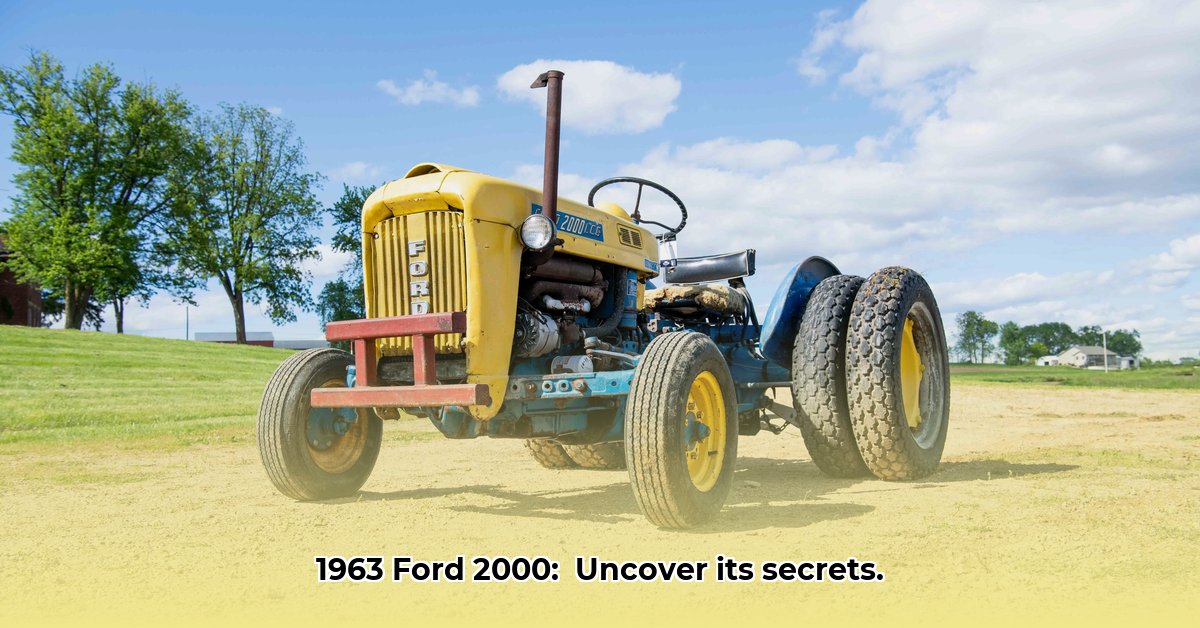
The 1963 Ford 2000 tractor wasn't just another piece of farm machinery; it represented a significant step forward in Ford's agricultural equipment line and mirrored the technological advancements of the 1960s. For more detailed diagrams, check out this wiring diagram resource. This comprehensive guide explores its specifications, historical context, and lasting impact, appealing to collectors, historians, and anyone interested in this iconic machine.
Specifications and Features: A Detailed Look
The Ford 2000 offered farmers a versatile machine capable of handling a variety of tasks. The heart of the tractor lay in its engine options: a 2.2-liter four-cylinder gasoline engine or a slightly larger 2.4-liter four-cylinder diesel option, providing a balance of power and fuel efficiency tailored to individual needs. This adaptability was a key selling point.
Transmission choices further enhanced its versatility. Farmers could select from simple 4-speed, more advanced 10-speed, or even 12-speed versions, providing optimal control and flexibility across various terrains and workloads. These transmissions were designed to optimize performance, ensuring smooth operation under diverse conditions.
Power output was substantial, boasting a gross engine power of 48.4 horsepower. Crucially, it delivered a robust 28 horsepower at the drawbar (for pulling implements) and 31 horsepower at the power take-off (PTO) shaft (for powering equipment like balers). This ensured efficient performance across a broad spectrum of fieldwork.
Many Ford 2000s were equipped with a front-end loader option, significantly expanding their capabilities beyond basic field work. This allowed farmers to easily manage materials like hay bales and manure, improving efficiency. Steering options, including manual and power steering, catered to varied field conditions and ease of maneuverability.
Here's a summary of the key specifications:
| Feature | Specifications |
|---|---|
| Engine Options | 2.2L 4-cylinder gasoline, 2.4L 4-cylinder diesel |
| Transmission | 4-speed, 10-speed, 12-speed |
| Power Output | 48.4 hp (gross), 28 hp (drawbar), 31 hp (PTO) |
| Steering | Manual, Power |
| Options | Front-end loader |
Historical Context & Market Performance: A Competitive Landscape
The early 1960s witnessed remarkable advancements in agricultural technology. Tractors were becoming more powerful, efficient, and adaptable. The Ford 2000 entered a highly competitive market dominated by established players like John Deere and Massey Ferguson. While precise market share data remains elusive, Ford's production of over 40,000 units suggests considerable success. Interestingly, Ford also offered a three-cylinder version, potentially targeting smaller farms or budget-conscious buyers. Did this strategy ultimately benefit or hinder overall market penetration? Further research into sales data and consumer perceptions is needed to fully answer this question. This lack of readily available data highlights a significant area for future research.
Operational Characteristics & User Experiences: A Farmer's Perspective
Anecdotal evidence suggests the Ford 2000 was a reliable and hardworking machine. Although perhaps not matching the horsepower of some competitors' top-of-the-line models, it proved more than sufficient for a wide range of applications. Its relatively simple design likely contributed to easier maintenance, a significant advantage for farmers prioritizing uptime. This simplicity, however, might also have meant fewer advanced features compared to some rivals. Detailed user accounts from the era would greatly enhance our understanding of its operational characteristics and long-term reliability.
Stakeholder Perspectives: A Lasting Legacy
The Ford 2000 continues to resonate with collectors, historians, and researchers. Its historical significance and straightforward design are highly valued. For collectors, restoring one is a labor of love, preserving a tangible piece of agricultural history. Historians see it as a valuable artifact representing technological advancements of the era. Restorers appreciate the challenge and satisfaction of returning these machines to their former glory. The ongoing efforts to preserve and restore these tractors are vital in maintaining their legacy.
Conclusion: A Workhorse's Enduring Appeal
The 1963 Ford 2000, while perhaps not the most powerful tractor of its time, carved a significant niche for itself. Its robust design, versatile features, and relative ease of maintenance made it a reliable workhorse for farmers across diverse agricultural settings. Its enduring appeal today among collectors and enthusiasts highlights its lasting legacy as a key instrument of agricultural mechanization during a pivotal era in farming history. Further research into its market performance and detailed user experiences would add valuable context and provide a more complete picture of this significant machine.